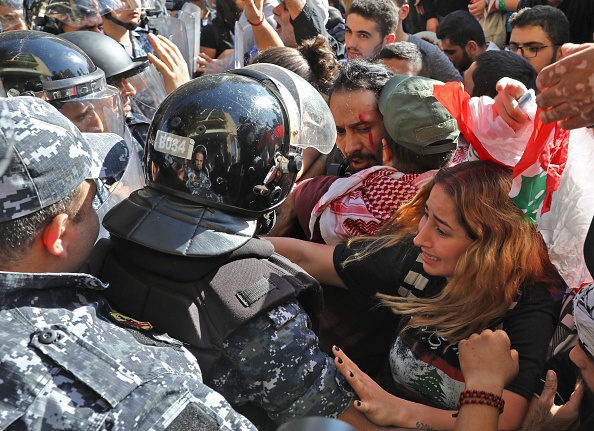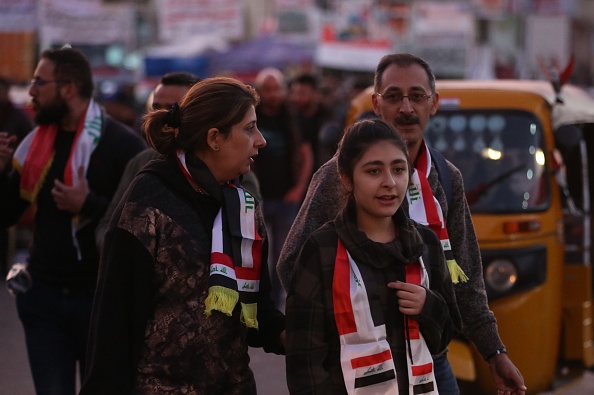Iran and its proxies are facing their most difficult domestic and regional challenges. They cannot blame these protests on the West, such as the US and Israel. But they also cannot portray them as ISIS or Al-Qaeda. The beauty of these protests is that they are genuine and real. They are leaderless and nobody was able to infiltrate them with a political or ideological agenda. That is exactly why the Iranian regime is sacred.
Iran has been doing what it does best; that is using extreme force against protestors. Their violent methods have worked in the past. For example, they have managed to quell the 2009 Green Revolution in Tehran. However; the regime hasn’t realized that this time around, these tools are no longer successful because simply, the people have nothing left to lose.
HEZBOLLAH IN LEBANON
For the first time since Hezbollah was formed in the 1980s, Lebanese Shiites are turning against it. Not only they are losing their support base; Hezbollah sees the protests as a whole as a first stop of losing its first official state in Lebanon. In 2018, Hezbollah and its allies won the parliamentary elections and managed to form a majority parliament and government, in addition to their allied president.
Through that influence within state institutions, Hezbollah crept into the state and had been able to control all of its key decisions. The party will not let go of al this without a fight. That’s why Hezbollah had to side with the authorities and the corrupt political class, against the Lebanese people.
By doing so, Hezbollah declared itself the enemy of the people. Long gone their heroic rhetoric about resistance and fighting injustice. Today, Hezbollah is the injustice incarnate.
Their main reaction is to use their thugs and influence within security institutions to suppress the protests. Not a day passes in Lebanon without someone arrested or violated, mostly in Hezbollah’s core areas in the South and the Bekaa regions.
This has worked in 2008 during the May 7 events, where the use of force stopped the undesired change. However, this time is different. They are not fighting their political opponents. They are fighting the Lebanese people, who have nothing left to lose. After each use of force, beating or threat, people go back to the streets in bigger numbers.

SAME STORY IN IRAQ
The Iraqi people – although they are fed up with the same economic grievances – have redirected their rhetoric against Iran. It has become obvious that Iran is the sole faction responsible for the Iraqi people’s ailments and pains. The corrupt political system put in place is not fooling the Iraqis, who took to streets despite all the threats.
Iran’s Quds Force General Qassem Soleimani was flying hysterically between Beirut and Baghdad trying to quell the protests. He decided to do what he does best: violence. He had a more violent plan for Iraq, where his forces and his proxies started shooting protestors in daylight, with no concerns about any accountability, knowing that no one will interfere.
He was partially right: no one interfered. But that also played for the benefit of the protests, which managed to stay leaderless and un-tied to any western interference. Again, like in Beirut, violence proved to be an outdated method, and people – despite the hundreds of killings and thousands of injured – went back to the streets and their rhetoric against Iran strengthened.

THE IRANIAN PEOPLE JOIN THE STREETS
It was not a surprise to see the Iranian people take to the streets. In a way, Iran has been exporting the revolution for decades. Finally, the people’s revolutions in Iraq and Lebanon are now transporting theirs to Iran.
The street protests in Iran – although stated with complaints against gas prices – it was really much more than that. The rise in prices was just a peg that sparked long and deep-rooted disillusionments and disappointment with the regime practices. Chants across all Iranian cities and towns are no longer about the gas prices or the deteriorating economy. They were about the regime’s corruption and disregards of its people’s needs.
Criticism of Iran’s regional operations and support for its regional proxies were heard loud and clear. Of course, everyone realizes that the US sanctions worked in squeezing the regime’s financial resources, but the Iranian people's criticism focused on the regime’s behavior rather than the US sanctions policies. It is significant that the Iranian people – like the Lebanese and the Iraqi people – realize that their enemy is within. Conspiracy theories no longer work. The rhetoric of resistance - and justifications for a resistance economy – is not successful anymore.
Nor is violence. More than a hundred were killed in Iran since the protests started, and many more have been arrested. But that doesn’t seem to be a factor of scaring the Iranians back home. Again, they feel that they have nothing left to lose. Like in Iraq and Lebanon, fear doesn’t work when you have nothing left to lose: no job to go back to, no security, no dignity, and certainly no prospects for a better future.
SO WHAT CAN IRAN DO?
It would be naïve to think that these demonstrations would topple the regime in Iran or its proxies in Lebanon and Iraq. The absence of a unified international policy on Iran – and Lebanon and Iraq - means that the protestors will be left alone to deal with their domestic challenges. However, this is a rare moment that is shaking the core foundations of the Iranian regime across the region. It is nota small detail that the Shia communities across these three countries are telling Iran that they aspire to a different identity.
Without the Shia communities, Iran will lose a very significant pillar of its power. Iran – even if it is not going to see a regime change soon – will be constrained. The Shia revolt across the region will make Iran think twice before starting a war. War will probably be its last resort, but also the beginning of its end.
Iran will continue using the same methods of violence, hoping that eventually, people will leave the streets. Whether they succeed or not, it doesn’t really matter. We all now know how vulnerable the Iranian regime and its proxies are. But most importantly, the Iranian regime is more aware of its vulnerability than ever, and its shaking.









